Archive for the ‘Leo Babauta’ tag
12 Goals: Define and Track Your Habits & Tasks (Step 3)
Before starting with Step 3, you might first want to read the introduction, Step 1 & Step 2.
Twelve Goals (or 12 Goals) is a goal-setting program for beginners. If you’ve never set goals before – or if you’ve tried and failed – Twelve Goals can help get you unstuck and on path to achievement. There’s nothing magical or mystical about this process at all. In fact, it’s downright boring and overly practical; you aren’t going to find any talk about magnetism, psychic powers, or the law of attraction. What you’ll find is a systematic way to look at your personal goals over the course of a year, along with some step-by-step advice and accompanying tools to help you achieve them.
Twelve Goals is still very much a work in progress. My hope is that the program will adapt and evolve over the course of 2010 based on feedback from you! If you ever forget how to find these posts, they will be available at www.12goals.com (or www.twelvegoals.com).
Breaking Down Each Goal
I find it fascinating that most people plan their vacations with better care than they plan their lives. Perhaps that is because escape is easier than change. – Jim Rohn
Twelve Goals is an annual plan you create for yourself. A plan of inspiration, a plan of action, and a plan you can be accountable to.
By this point, you should have all twelve of your goals locked and loaded for the year. It’ll probably be frustrating then to hear that even though they’re 99.9% committed, they can still change throughout the year. How so? By identifying what it will take to actually achieve them given your circumstances.
In Step 2 you probably did a “squint test” or “t-shirt sized cost (i.e. Small, Medium, Large, X-Large) ” of feasibility. Meaning: if you squinted hard enough you could probably see how a particular goal could be achieved in the month you assigned it to. But guessing really isn’t good enough. Sometimes you don’t know just how much work needs to happen in order to get something accomplished, and it’s easy to get sidetracked or delayed by unforeseen events.
This step is all about figuring out what it’s going to take. It’s about getting real. But it’s also about being agile and adapting your plan throughout the year as conditions change.
In project management, the approach of breaking down a project into smaller work items is called a work breakdown structure (or a work backlog). As defined by Wikipedia, a work breakdown structure consists of "the end objective, successively subdividing it into manageable components in terms of size, duration, and responsibility which include all steps necessary to achieve the objective.”
In Twelve Goals parlance, this is identifying every task that needs to be checked off in order to accomplish your goal.
Sounds like a lot of work… and it can be. But spending the time now to squabble with yourself about what it takes to make something happen is better than fighting yourself when you’ve hit a wall halfway through your second month. There’s nothing more frustrating than assuming you know how to do something, just to find out you weren’t ready to begin with. In other words, this step above everything else is about being honest with yourself about where you are, what you need to do, and what needs to happen around your goal to make it achievable.
Preparation is key.
Defining a work breakdown structure for a complex project can be harder than coming up with a task list for a single goal, but the intent is the same. Your primary objective throughout this process is to learn. Learn everything you can about the thing you’re going to accomplish so you have all the ammunition you’ll need when you need it.
Remember: your future self is lazier than you are right now. Right now you have energy, you have positive intent, and you have that elusive feeling that you can conquer anything. Use this vigor for the next few hours to lay out your plan for the year. Because if you do it now, you’ll have something to refer to for the next twelve months. No excuses.




